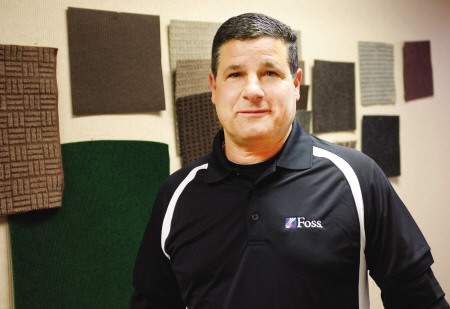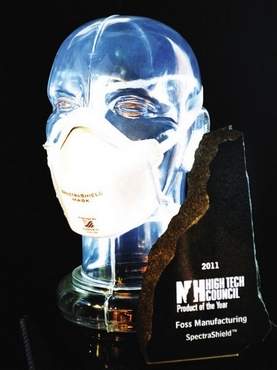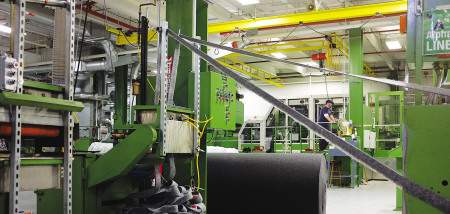Foss will add production jobs in Georgia instead
By Nick B. Reid
Seacoast Sunday, March 24, 2013
[The following article is courtesy of Seacost Sunday and Seacoast Online.]
 HAMPTON — Foss Manufacturing seems like a prime example of the recovery of the region's manufacturing industry, having bounced back from significant layoffs in 2009 to re-create more than 100 jobs and reach new employment levels.
HAMPTON — Foss Manufacturing seems like a prime example of the recovery of the region's manufacturing industry, having bounced back from significant layoffs in 2009 to re-create more than 100 jobs and reach new employment levels.
But even as the supplier of high-tech, non-woven fabrics and specialty synthetic fibers, nears 500 employees and new levels of sales, it's shifting its center of manufacturing to the Sun Belt.
Foss Chief Executive Officer A.J. Nassar said 2008 was "a complete refit for the company" and he decided during the economic downturn to "basically tear the business apart and go into a lot of new business lines."
Foss spent more than $20 million on that effort, according to Nassar, and now revenue has almost doubled, 70 percent of the products it makes today weren't offered six years ago and 60 percent to 70 percent of business is being done with new customers. Consequentially, Foss created more than 100 jobs in the past 14 months, Nassar said.
But despite the company's success, its story isn't a local fairy tale that inspires new confidence in the future of manufacturing in the Northeast. Nassar said there's inherent difficulty in finding good manufacturing workers in New Hampshire, and Foss's current focus is on building a 220,000-square-foot manufacturing facility in Rome, Ga., where 150 manufacturing laborers are expected to be added in the first three years. Nassar said the Georgia location will be "strictly manufacturing," but he's still hiring production workers in New Hampshire and expects administrative, research and customer service roles to continue to expand locally.
"This company is here so we build it, but some of the hurdles that keep you from bringing new manufacturing in this area are great and probably insurmountable to allow you to bring (manufacturing) companies into the state," Nassar said, adding the state has helped in providing development loans but has lacked in other areas.
Southern states have the advantage of programs organized by those states through which workers are trained for 60 to 90 days on the respective state's dime within private manufacturers' facilities, "almost like a vocational school inside your facility," Nassar said.
Energy costs in the south are one-tenth of what they are in the Northeast, he added.
"Why would someone locate a manufacturer in the Northeast when they can go to South Carolina, North Carolina, Georgia, and they'll train your people, they'll give you subsidized power, they'll give you no taxes for five years," Nassar asked.
In 1990, 19.4 percent of New Hampshire's jobs were in manufacturing, according to The Associated Press. By 2006, that number had dropped to 12.1 percent. But U.S. manufacturing expanded in February at the fastest pace since June 2011, buoyed by increases in new orders and production. The third straight month of growth suggests factories may help the economy this year after slumping through most of 2012.
The Institute for Supply Management said its index of factory activity rose in February to 54.2, up from January's reading of 53.1. A reading above 50 indicates expansion.
But Nassar said it's been a struggle to find motivated workers in New Hampshire.
"It's been interesting because you would think that if you were hiring you'd have hundreds and hundreds of applications in this kind of economic environment, but it's extremely hard, especially in the mid-price-range jobs, the $35,000 to $50,000 jobs," Nassar said. "You've got to go through 10 people to find one that really wants to work."
He said extended unemployment and government benefits tell people: "Why work? Stay home."
"There's so many incentives that tell people to stay home and not go out and get a job," Nassar said. "Literally, we've had people tell us, 'Well, I'd like that job, but it's only $100 difference than what I'd collect on unemployment so I think I'll stay home.'"
Nassar said in the past 30 days he's hired two workers at the executive level and six at the production level.
"We probably looked at 25 people before we selected those six (production workers)," Nassar said, noting the cost of training temporary workers only to see them not work out, compared to southern states that might offset some of that training cost.
He said other than costs of raw materials and personnel, energy is the biggest factor in manufacturing and southern state s lower that cost through subsidies.
s lower that cost through subsidies.
"During the month of February, you could buy power in states like Georgia and the Carolinas at one-tenth what it would cost you to produce power here," Nassar said. "It's insanity."
Nassar touted New Hampshire's work force as one of the most educated he's seen and said the state has been "wonderful" in providing loans that helped Foss work its way out of bankruptcy in the mid-2000s. But when it comes to manufacturing, he said, more has to be done if businesses are going to be enticed to start in the state or move here.
"It's almost like a conscious effort has been made by the states up here to not attract manufacturing," Nassar said.
Return to Foss Manufacturing Table of Contents

